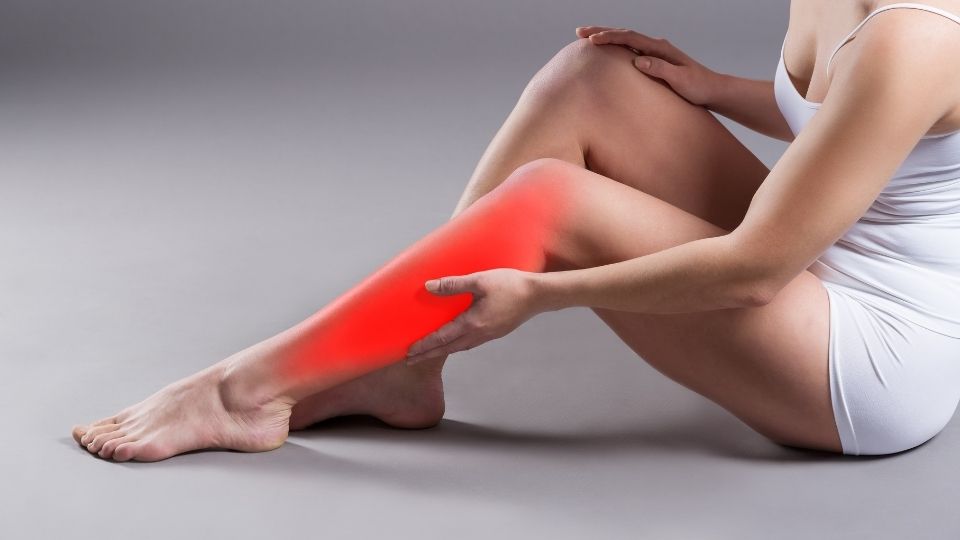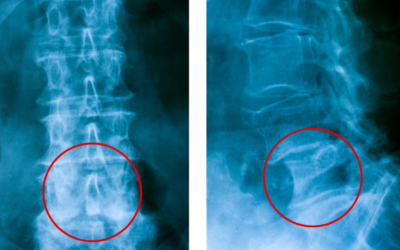Chiropractor Explains: Leg Pain From Sitting in Office Chair
Leg pain while sitting in an office chair is usually the result of muscular imbalances by your body adapting to a complacent posture for too long. Throughout my thirty years of practice, I find that the core is usually weak and imbalanced and is the core cause of most aches and pains.
As a general rule, an office chair can cause leg pain due to prolonged periods of strain and pressure. While sitting, hip flexor muscles shorten, which can cause severe stress on the hips, cause swelling in the legs, and discomfort in the sciatic nerve. Remember to stand up regularly and stretch your legs.
Here’s why you need to read this article:
Over the past 30 years, I’ve been a chiropractor, as well as an ergonomist. I’ve published a book on posture, appeared on national television, launched a successful Kickstarter campaign for a posture-correcting device; designed many posture inventions; and have a 10K+ subscriber YouTube channel on this subject. In summary, I’m confident that I can provide you with some helpful advice and practice! I know that I can impart some excellent advice that you can start implementing today!
Why Traditional Office Chairs May Cause Leg Pain
Therefore, you have a short, strong muscle facing a longer, weaker one. For example, the chest muscles counterbalance the upper back forces, performing opposite functions – pushing and pulling.
If you are into super easy and inexpensive alternatives to office chairs, I wrote a fantastic article on how and why you should consider these options for back pain and I encourage you to read it!
When sitting for a long time, your shoulders and head may be bent forward, which can cause tight chest muscles and weak upper back muscles. Your hip flexors may shorten and pull the pelvis forward, resulting in back and leg pain.
Here are a few reasons why you are weak in your core:
Kyphosis. A person with this type of muscular imbalance might sit or stand with their head tilted forward and their back rounded.
Lordosis. Muscle imbalances are also found in the abs and lower back. Many people have weak abs while the back muscles are stressed during sitting. They then cave in, protruding into the stomach.
Leg imbalances can also result in knee and hip pain. Since many people cross their legs while sitting for long periods, their inner thighs can become overly tight. If the inner thighs become too tight, they can cause rotation of the femur bone (thigh bone), leading to knee pain. Some people, on the other hand, tend to sit with their legs more open, which causes tight outer thighs.
How to Deal With Leg Pain from Desk Chair
- Get up every 20 minutes or so, stretch those sore muscles, or take short walks to relieve aches and pains. Also, try strengthening the weak muscles and releasing the tight muscles.
- Ensure that you are sitting in the correct position. The seat should be raised as high as possible while keeping your feet flat on the ground. Select an appropriate seat depth so that your back is firmly held against the backrest and your knees are 2 to 3 fingers away from the edge of the seat.
- Adjust the forward tilt on your chair to ensure your hips are well above your knees. Sit straight, not slouching, and keep your eyes level with the screen. When using a mouse, your elbows need to be at a 90-degree angle.
Best Seat Cushion for Leg ComfortDoctor's Recommendation
Black Friday Offer!
Get 35% off Orthopedic Seat Cushion
Product DetailsResearch-based Design
Recommended ForBack Discomfort
Video Guide
Video Guide
How to Deal With Leg Pain Outside of the Office
- Outside of the office, movements such as weight lifting and stretching can improve muscular balance. A good way to identify short, tight muscles is by looking at open, slack ones. If your chest is tight and your back is weak, you can stretch your chest muscles and strengthen your upper back with exercises like lat pulls or reverse flies.
- Stabilising your core with side planks and planks will ease your back pain and tighten your abs. Leg aches and pains usually go away with regular exercise. These exercises are good choices to strengthen your abs.
9 Things That Happen to Your Legs When You Sit While Working:
The most common posture in the world is sitting. The average person spends more than 10 hours per day sitting and does so for more than half of their life. Sitting can be great for your health with a few simple changes that will allow you to sit comfortably while still maintaining good posture. Read on to learn how harmful it can be to sit all day:
1. Weak Gluteal Muscles
Sitting for long periods of time can cause weakness in your glutes. Sitting causes blood to pool in the veins that run through your lower body and this prevents them from pumping blood up to your heart.
When you stand, these veins are squeezed by gravity, which forces the pooled blood back up towards the heart. When you sit, they stay compressed and don’t work as hard to pump blood upwards. This is why sitting for a long period of time can make it difficult to get up when you want or need to do so!
Here is an exercise video that I made:
2. Lower Back Pain
It seems like everyone is talking about how bad sitting is for our backs. The problem with sitting all day is that it leads to a forward head and rounded shoulders, which puts stress on the back muscles and ligaments. It also causes your pelvis to tilt too far forward, which can lead to lower back pain. If you don’t use an ergonomic chair or have poor posture, sitting causes your hip flexors to shorten, and it’ll hurt your back. Poor posture can also lead to compression of your discs, which causes early degeneration that leads to chronic pain.
3. Shoulders and Neck Pain and Stiffness
It is a common occurrence for office workers to experience neck and shoulder pain when they sit all day. The forward head posture of sitting at the computer can lead to chronic tension in the upper back, shoulders, and neck muscles. This post will cover various ways you can combat this issue by using items that are already available in your home or office. There are a number of factors that can contribute to shoulder and neck pain and stiffness when you sit while working. These include:
- poor ergonomic workstation setup
- inadequate chair height
- lack of arm support while typing
Black Friday: 35% Off Today
Typical Delivery 1-3 Days
4. Weight Gain
Working in an office for long hours can cause more weight gain than many people realize. One of the most common reasons is because you are sitting down while working which causes a change in your metabolism. This means that when you sit, your muscles become less active and this changes how calories are burned.
5. Depression
We often associate depression with sadness. It’s a natural reaction to feeling negative emotions, but it can also manifest as physical symptoms such as fatigue and lack of energy. In recent years, the concept of “sitting disease” has become popularized by experts in the field who believe that prolonged periods of sitting are bad for your health. They say that this causes an increased risk for obesity, diabetes, cardiovascular disease and many other chronic conditions.
One possible solution is to stand while you work or take quick breaks throughout your day to stretch or walk around. This will help alleviate those feelings of being sluggish and may even lead to better productivity!
6. The Diabetes Risk
The health risks of sitting for long periods while working are difficult to ignore. Studies have shown that the risk for diabetes rises up to 50% when you sit a lot. This is because prolonged sitting has been linked with increased levels of insulin resistance, which can lead to type 2 diabetes and obesity-related diseases such as cardiovascular disease, hypertension, and stroke.
7. Cancer Risk
Working in an office can come with many hazards. One of the least discussed is the risk of developing cancer from sitting too long. In fact, recent studies have shown that people who sit for more than 3 hours a day are at increased risk for colon and breast cancers.
8. Cardiovascular Disease
For many people, sitting at a desk for hours is part of their daily routine. For office workers, this is especially true. But what most people don’t know is that those long periods of sitting can lead to health problems like heart disease. For example, one study found that the overall mortality rate increased by 50%. Sitting down has similar mortality rates to smoking.
9. Varicose Veins
We spend hours on end sitting in our office chairs, but have you considered how this can affect your body? Sitting for long periods of time can compress and stagnate the veins that bring blood back to the heart. These are called varicose veins. If you work in an office, chances are you spend a lot of time sitting. And if you’re like most people, your job requires some mental or physical exertion that causes your feet to swell.
What is the Best Seat Cushion for Leg Pain?

As a chiropractor, I have had many patients who have reported experiencing leg pain while sitting. I have experimented with different seat cushions in an effort to find one that would provide both support and comfort and also aid in spinal alignment. After researching various options, I ultimately decided to create my own seat cushion to test with my patients who reported back pain.
After testing different materials and designs, I created a seat cushion that my patients found to be effective. The cushion has a unique shape that provides support and comfort, and also promotes a certain alignment. It is made of high-quality memory foam and has a removable and washable cover. I am pleased to have found a solution that helps my patients to feel comfortable and improve their experience.
When searching for a comfortable seat cushion, there are various factors to take into account. My top priorities were support, density, and stretch. After experimenting with several prototypes, I came up with a cushion that met all my standards. The cushion has a natural latex core that is more supportive than other materials like memory foam or polyurethane foam. It also has a higher density that promotes a certain alignment. The vegan leather cover is stretchy in all four directions, making it both comfortable and durable. This cushion has helped many of my patients to improve their experience, and I believe it could be helpful for you as well.
I explain the concept of my design on a TV show HERE
The Problem That I Found with Most Seat Cushions for Leg Pain:
I made a video explaining different types of foams:
I was surprised how similar cheap memory foam seat cushions were on Aliexpress from the listing on Amazon!
Conclusion
It is widely believed that standing up will counteract the negative effects of excessive sitting. Standing in one position for too long isn’t healthy, either. However, the issue involves time spent sitting rather than time spent moving. Any posture in which there is minimal energy expenditure may cause health issues whether standing or sitting. You may experience back pain, varicose veins, and even worsened symptoms of heart disease or arthritis if you stand too much. However, if you stand at least six hours a day, you reduce your risk of obesity. Ideally, you should balance sitting, standing, and moving.











